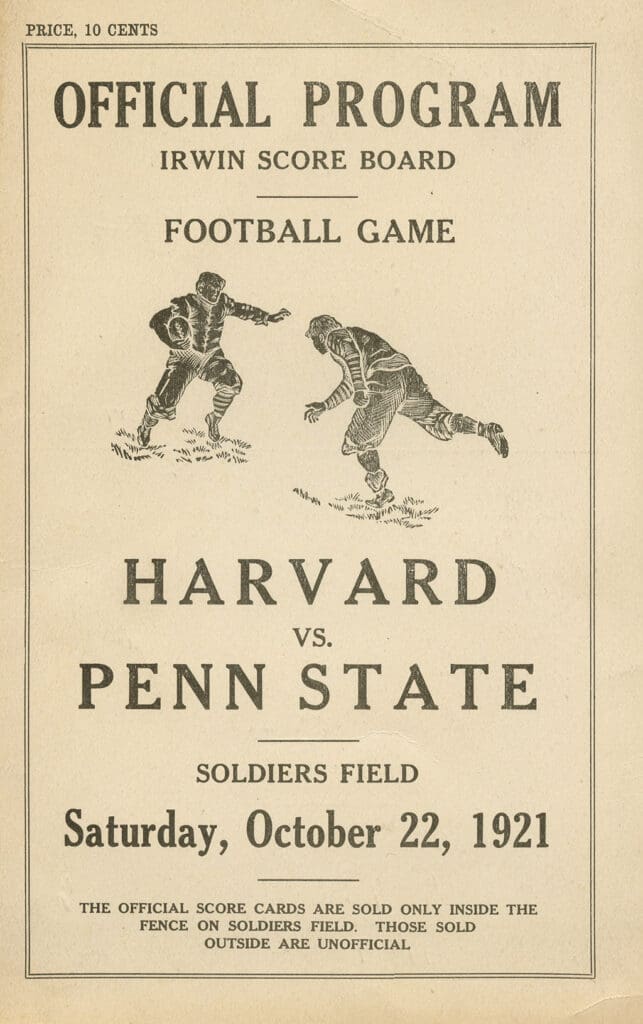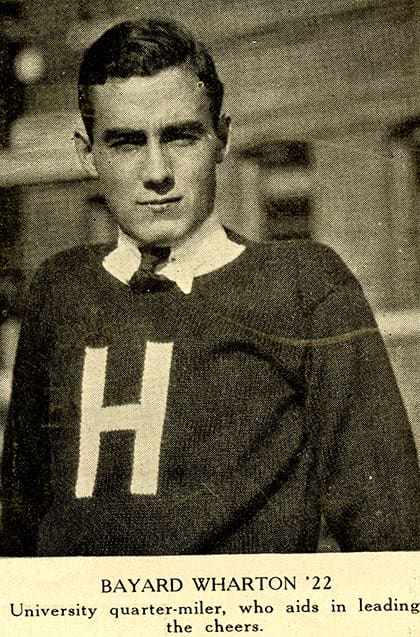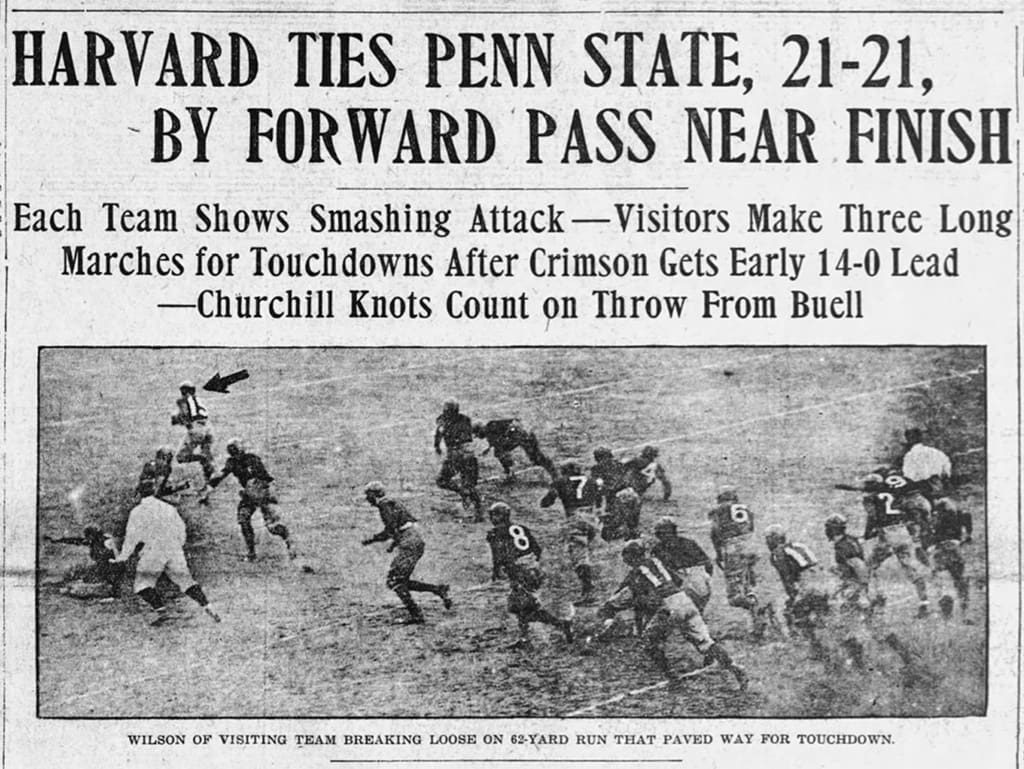October 22, 1921 Centre-Transylvania / Harvard-Penn State
Transylvania had to at least be credited for stepping up to the plate again. The school had found itself going south in the relationship with Centre, just like Georgetown and their fellow Lexingtonians, the University of Kentucky.
In 1915, Transy put a 38-0 defeat on Centre. The Colonels managed a 0-0 tie the following year, and then the tables not only tilted, but literally turned over on the Crimsons, ( later, the Pioneers ), and Centre began a major domination.
1917 Centre 28 Transylvania 0
1918 Centre 52 Transylvania 3
1919 Centre 69 Transylvania 0
1920 Centre 55 Transylvania 0
The last 4 years had Centre winning by a cumulative score of 204-3, which along with the big wins over Kentucky and Georgetown, established without debate who was the kingpin of football in the Commonwealth of Kentucky.
The 1921 game was to be played in Lexington, and since it was to be the last Lexington appearance of the famous Kentucky Colonel, Bo, a sell-out crowd was expected, and extra bleachers were thrown up at Transy's stadium to accommodate the crowd. It was also to be the last appearance of Army and Bill James, and possibly Ben Cregor and Chick Murphy. But it has to be accepted that it was Bo who was the big draw, even though Uncle Charlie constantly drilled into the Colonels that it was a team game, and no one individual was more important than the team as a whole.
The week before the Transy game wasn't spent preparing for the Crimsons from Lexington but rather the Crimson from Cambridge.
It was getting intense. There had been a year's mental preparation, and the early season's games had been designed with the October 29 showdown always in mind. Now the time was near, just two weeks away.
Monday, October 17, Uncle Charlie's son, Tom Moran, took the third team and other scrubs over to the baseball diamond behind the stadium. Red jerseys had been ordered from Sutcliffe's in Louisville and were worn by the subs who were to run anticipated Harvard plays against the first two teams. Tom Moran spent the day teaching the Crimson formations to his charges.
Meanwhile, Uncle Charlie, Tiny and the Chief, held a chalkboard session in which new plays to be used against Harvard were diagramed, and then walk-through sessions were held out on the field.
"No, Hump. First do a stutter-step left and then pivot and sweep wide right."
"That's right, Army. You take out the left side linebacker."
Nothing was to be left to chance. It was game time, even though the actual date was still 12 days away.
On Tuesday, a full scrimmage of four 15-minute periods was held with the first and second teams against the scrubs decked out in their crimson jerseys. First the reserves ran the Harvard plays against the starter's defense, then the second team took over for the next period and defensed the anticipated attack.
Back and forth it went, and then the first and second teams went on the offensive and ran against what it was felt would be the Harvard defensive formations. Red Roberts was switched to the backfield and ran some power plays designed for short-yardage situations, when just a yard or even less was needed.
The same type of vigorous practice took place on Wednesday, attended by George Joplin who wrote a piece for the Danville "Messenger" which appeared in the paper on Thursday, October 20.
While the Sunday papers give glowing accounts of the varsity football team, mention is never made of the squad of scrubs who went out day after day and got the livin' daylights kicked out of them by this same crowd of varsity performers. They knew it was coming, day after day-nothing but kicks and bruises. It was, and is today, this heroic gang of third stringers that fit the varsity for the test.
When the list is made out, the day before the team is to make a trip, they huddle up in the corner of the dressing room and nurse some forlorn hope that maybe-maybe their name will be on the list. It seldom is. Yet they never utter a complaint. A regular halfback or lineman may let out a loud squawk when he is removed from a game. He never considers that there are a dozen men back home who would have given his right arm to have played as long as he.
When Jack Dempsey knocked out George Carpentier last July, there was nothing said of his sparring partners. Week after week, these lads faced and gamely took their medicine. It was this crowd who fitted Jack for the acid test. Jack got the money and credit, they got the air.
Out on Cheek Field every afternoon the spectators will see a crowd of red-jerseyed youths fight for all they are worth to check the dynamic assaults of the first and second teams. The first team will have their turn smashing into the mass of red. Then the second team, all fresh, will open up their guns. When the powder has cleared away, and the scrimmage is over, one will find a battered, bleeding, weary, heavy-footed gang still holding the fort. Their goal line may have been crossed a dozen times during the afternoon, but they have battled and are inwardly proud of their showing.
When the train to Harvard pulls out for Boston next Wednesday morning, this red-sweatered clan will be down at the station. They won't board the train, but they will join in with the rooters in giving the team a rousing send-off. They will envision the Harvard game here at home, play by play, as it comes in over the wires, and they will be thrilled by the achievements of their big brothers. No finer spirits can be found anywhere, and in perhaps another year or two, their names will find a place in the streamers that run across the city sports pages.
Scrubs, our hats are off to you!
Whether it was due to George Joplin's piece or not, Centre took every player who had a uniform, 41 in all, on the train over to Lexington.
The Colonels outweighed the overmatched Transylvania team by 21 lbs. per man.
Centre slaughtered the Crimsons, 98-0. Uncle Charlie played everyone who made the trip.
Red Weaver came over from Montgomery, West Virginia, where he was coaching the West Virginia Trade School football team. He watched the game from the sidelines. It seemed appropriate that he was in attendance when Centre's amazing extra point streak finally ended.
After the Colonels' third touchdown, Bo's kick was wide. The miss ended the successful boots at 109 straight.
It was 26-0 at the end of the first quarter, 60-0 at the half, and 88-0 after three quarters.
Army and Transy's captain decided to lop 5 minutes off the final period, and Centre still scored a TD and kicked a field goal to reach the 98 points total, achieved with 14 touchdowns, 11 extra points, and the field goal.
When the last of the Colonels' subs ran out onto the field, George Joplin must have felt good about his column two days earlier.
The 98-0 win meant that in the last five years, Centre had outscored their old Kentucky rival by a combined 302-3. The five contests were played over a total of 295 minutes, so Centre averaged over a point per minute during the run. Transylvania tossed a white flag onto the turf, and the two colleges didn't meet again until 1924.
While Centre was enjoying a romp, things weren't so easy in Cambridge.
Harvard was understandably quite confident when the schedule was made out for 1921. And why not? The Crimson had enjoyed so much success in the past that it was just understood that the winning ways would continue. However, in scheduling Indiana, Georgia and now Penn State on consecutive weekends, and then with Centre to follow the Nittany Lions, the Crimson had packed the middle of their season with some real, quality opponents, and the games with their arch rivals, Princeton and Yale, along with Brown, still remained.

Penn State 1921
The "Nittany Lion" nickname of the Penn State athletic teams had an origin somewhat like that of Virginia Tech's "Hokies" in that both were the product of a student's imagination. Penn State was playing Princeton in baseball in 1904, and a Penn State student, Harrison D. "Joe" Mason, was shown a statue of Princeton's famous Bengal tiger, an example of the ferociousness of the Princeton athletic teams.
Mason replied that a Nittany Lion, an imaginary beast, was the fiercest of all animals, and would overcome any "mere tiger." The instant fabrication stuck, and the Nittany Lions and Penn State have been synonymous since.

The Penn State mascot, an imaginary "Nittany Lion," created to combat the Princeton "Tiger"
Hugh Bezdek had taken over the Penn State head coaching position during the war shortened 1918 season and jump-started the program the following year. Penn State was tough. The Pennsylvanians were 7-1 in 1919, losing only to Dartmouth in Hanover, 19- 13, and went 7-0-2 in 1920, the ties being with Lehigh and Pittsburgh, both on the road.
Thus far in 1921, Penn State was undefeated at 4-0.
Penn State 53 Lebanon Valley 0
Penn State 24 Gettysburg 0
Penn State 35 North Carolina State 0
Penn State 28 Lehigh 7
Coach Fisher and his staff spent the week prior to the Penn State game once again shuffling the starting line-up. In the practice sessions, 7 players who hadn't started against Georgia were put on the first unit.
The only back who had started against Georgia still on the first string was George Owen, the fullback. Jewett Johnson was to replace Charles Buell at quarterback. Winnie Churchill, the Crimson who had visited Danville over the past Christmas vacation, was starting at halfback along with Vinton Chapin.
Several linemen were moved in and out of starting positions during the week, with the Harvard coaches determined to get an eleven on the field which could put some points on the board.
In addition to the offensive woes which were worrisome, Harvard was going to be outweighed one of the few times in its long gridiron history, with Penn State having a 7 lb. weight advantage per man.
35,000 people attended the Penn State game in the Stadium, more than had attended the Georgia game, but far from capacity. The Nittany Lions showed the crowd that their growing reputation was well deserved.

The Crimson jumped out to a 7-0 lead after driving 70 yards on their first possession. Harvard then scored a second time to go up, 14-0, and it looked like business as usual. However, Penn State's defense tightened up and their offense came alive and suddenly the Crimson looked out of sync. A score by the Nittany Lions made it 14-7 at the half.
Percy Haughton, the former Harvard coach ( 1908-16 ) scampered out of the press box just before the half ended and hustled to the Crimson locker room. A reporter watched Haughton rushing out of the end zone, obviously heading to the locker room.
The squad looked like it had been talked to a bit, quite a serious array as it walked slowly back into the stadium after the half, especially as compared to the dashing way it introduced itself to the crowd before the game.
Penn State scored once in the third quarter to knot it at 14-14 going into the final period. Certainly, the momentum had changed, and the Nittany Lions’ power offense brushed right by, over, and around the Crimson defenders as they suddenly took it in again to go up, 21-14. The Pennsylvanians had put 21 unanswered points on the board, and things were looking quite serious in the big horseshoe.
Preceding the "12th Man" legend at Texas A&M ( which we'll get into later ) was an event which could have achieved the same legendary status as the Texas happening had someone promoted it.
It was unbelievable with the depth of the Crimson squad, but Coach Robert Fisher had run out of backs! Fisher got one of his backfield coaches to contact an "H" sweatered cheerleader named Bayard Wharton, a senior from Philadelphia who had prepped at Chestnut Hill Academy. Wharton had been on the football team the previous two years, but decided to concentrate on track and became a cheerleader in the fall of 1921.

Bayard Wharton was told that he may be needed and he raced to the locker room and suited up. As darkness fell over the playing field, the Crimson regained possession at midfield. Coach Fisher had a quartet comprised of two quarterbacks, a guard, and Winnie Churchill in the backfield.
The crowd was on its feet, cheering on their team. Methodically, junior Charles Buell directed what everyone knew would be the last drive of the game. Buell kept the ball on the ground, and by picking up 4-5 yards per carry, managed to take his team to the Nittany Lion 15. Two line plunges moved the ball to the 10, where it was 3rd and 5.
On the next play, Buell took the snap and drifted slightly left where he spotted Churchill out near the left sideline. Buell pulled up, fired a bullet, Churchill grabbed it, and danced across the goal.

Winnie Churchill, Harvard back who scored the tying TD against Penn State
Charles Buell calmly put the extra point boot squarely through the uprights to tie the game at 21-21. Harvard had escaped, but just barely.

Penn State in action while scoring three unanswered touchdowns.
Penn State won the battle of the statistics, rushing for 330 yards while holding Harvard to only 130. The Crimson passed for 67 yards. Penn State got 57 through the air.
Only 5 times since 1900, a period stretching over 206 games, had a team scored 21 or more points against Harvard.
Coach Fisher used 25 men in the game. He didn't put cheerleader Wharton in, but the young man stood by if needed. Doubtless, Wharton would have performed well if he'd been sent out onto the field. If his offer to suit up and "stand by if needed" had been publicized, as had been the later situation with Gill King at Texas A&M, we may have had another young man known as the "12th Man." His service in the Great War obviously proved his worth.

Upon returning back onto the Penn State campus, the Nittany Lions were met by the school band and the entire student body as they disembarked off the train. The whole throng made their way to the athletic field where speeches were made by Coach Bezdek and the players.
One member of the team, the captain, George Snell, hadn't been able to make the trip as he was in the infirmary with a throat infection. Captain Richmond Keith Kane of Harvard sent the game ball back to State College where it was presented to Snell with a warm note wishing him a speedy recovery.
It was the Harvard way.
When members of the Colonels received the results of the Penn State game, they were greatly relieved.
"We loved the Harvard players," Army was quoted as saying years later. "We always cheered for them except, of course, when they were playing us. And then, we wanted to be the ones to beat them. We wanted to go to Harvard and be the first team in many games to defeat what we considered the greatest college, and greatest bunch of guys."
